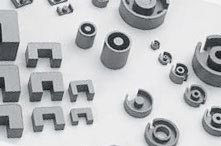A ferrite core is one of many different types of magnetic cores. Ferrite cores are combined with wound electric transformers. Ferrite is used for its high permeability and its low electrical conductivity. These two benefits allow ferrite to prevent eddy currents. A lack of eddy currents and consistent performance at high frequencies makes these cores ideal for RF transformers. Those who use AM radio receivers also benefit from ferrite toroids.

A toroid inductor is used in electronic circuits in order to allow for low frequencies while maintaining large inductances.
Ferrite cores can be made soft and hard. Soft ferrites have a higher coercivity than their counterpart, and so they are commonly used to make magnets. Soft ferrite is able to change magnetic direction with minimal hysteresis loss. Manganese-zine ferrite and nickel-zinc ferrite are the two most common types of soft ferrite.
Ferrite cores come in different sizes. A large core is found in powers transformers because they offer low frequency, where as a small core is used in a signal transformer because of their higher frequencies.
One downside when working with ferrite is it brittleness. Compared to metal cores, this core is more likely to be damaged from drops and bangs. Powder cores are stronger than ceramic cores, but weaker than metal.
For more information about ferrite cores, give us a call today!
Toroid
- Is Winding a Toroid Necessary?
A toroidal coil is an inductor in electronic circuits that allows for inductions at low frequencies when comparatively large inductances are required. - Toroids Confine Total B-Field
- Toroids in the Medical Industry

